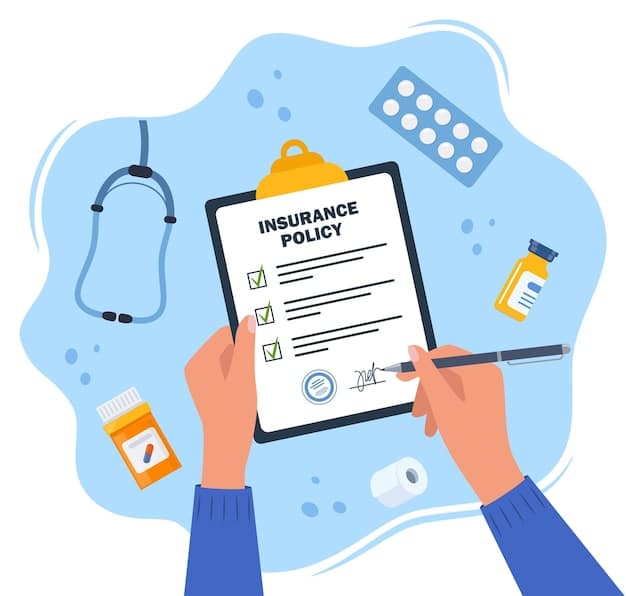Decoding Health Insurance Jargon: Your 2025 Guide to Choosing the Right Plan

Decoding Health Insurance Jargon: A Glossary to Help You Choose the Right Plan in 2025 is designed to clarify the complex terminology of health insurance, offering a comprehensive guide to help individuals make informed decisions when selecting the best plan for their needs in the coming year.
Navigating the world of health insurance can feel like deciphering a foreign language. This guide, decoding health insurance jargon: a glossary to help you choose the right plan in 2025, aims to simplify the terminology and empower you to make informed decisions about your healthcare coverage.
Understanding Key Health Insurance Terms
Choosing the right health insurance plan requires understanding the fundamental terms. This section breaks down the essential vocabulary, providing clarity and confidence as you explore your options.
Premium
The premium is the amount you pay monthly (or sometimes quarterly or annually) to maintain your health insurance coverage. Think of it as your regular membership fee to access healthcare benefits.
Deductible
The deductible is the amount you pay out-of-pocket for covered healthcare services before your insurance plan starts to pay. For example, if your deductible is $2,000, you’ll pay the first $2,000 of your healthcare costs before your insurance begins to cover its share.

Copay
A copay (or copayment) is a fixed amount you pay for covered healthcare services, such as doctor’s visits or prescription refills. It’s typically a relatively small fee paid at the time of service.
Coinsurance
Coinsurance is the percentage of covered healthcare costs you pay after you’ve met your deductible. For instance, if your coinsurance is 20%, your insurance pays 80% of the remaining costs, and you’re responsible for the other 20%.
Understanding these four basic terms – premium, deductible, copay, and coinsurance – is the foundation for comparing different health insurance plans effectively.
HMOs, PPOs, and More: Navigating Plan Types
Different types of health insurance plans offer varying levels of flexibility and coverage. Understanding the distinctions between them is crucial for finding the best fit for your needs.
- HMO (Health Maintenance Organization): Typically requires you to choose a primary care physician (PCP) who coordinates your care and refers you to specialists within the HMO network. Often has lower premiums but less flexibility.
- PPO (Preferred Provider Organization): Offers more flexibility, allowing you to see specialists without a referral and often providing some coverage for out-of-network care. Premiums are usually higher than HMOs.
- EPO (Exclusive Provider Organization): Similar to an HMO, but generally doesn’t require a PCP. However, coverage is typically limited to in-network providers only.
- POS (Point of Service): A hybrid between HMO and PPO plans, requiring a PCP for in-network care but allowing for out-of-network care at a higher cost.
When choosing a plan type, consider your healthcare needs, budget, and preferred level of flexibility. Do you want the lower premiums of an HMO or the freedom to see specialists without referrals from a PPO?
Essential Health Benefits (EHBs): What They Cover
The Affordable Care Act (ACA) mandates that all health insurance plans sold on the Health Insurance Marketplace (also known as Obamacare) cover a set of Essential Health Benefits. Understanding these benefits ensures you have access to vital healthcare services.
The Ten Categories of EHBs
The ACA outlines ten categories of essential health benefits that all marketplace plans must cover:
- Ambulatory patient services (outpatient care you receive without being admitted to a hospital)
- Emergency services
- Hospitalization (such as surgery and overnight stays)
- Pregnancy, maternity, and newborn care
- Mental health and substance use disorder services, including behavioral health treatment
- Prescription drugs
- Rehabilitative and habilitative services and devices (services and devices to help people with injuries, disabilities, or chronic conditions gain or recover mental and physical skills)
- Laboratory services
- Preventive and wellness services and chronic disease management
- Pediatric services, including oral and vision care
These EHBs ensure that all health insurance plans provide coverage for a wide range of essential healthcare services, protecting consumers from unexpected medical expenses and promoting access to comprehensive care.
Understanding the Formulary and Covered Drugs
Prescription drug coverage is a critical component of health insurance. The formulary is a list of prescription drugs covered by your plan, and understanding it can save you money and ensure you have access to the medications you need.

Drug Tiers
Formularies typically categorize drugs into tiers, each with a different copay or coinsurance amount. Lower tiers generally include generic drugs, while higher tiers may include brand-name or specialty medications. Understanding your plan’s drug tiers allows you to anticipate your out-of-pocket costs for prescriptions.
Prior Authorization
Some medications may require prior authorization from your insurance company before they are covered. This means your doctor needs to obtain approval from the insurance company to prescribe the drug, typically to ensure it’s medically necessary and cost-effective.
Reviewing the formulary and understanding the drug tiers and prior authorization requirements of your prospective health insurance plan is essential for managing your prescription drug costs effectively.
In-Network vs. Out-of-Network: Maximizing Your Benefits
Health insurance plans typically have a network of doctors, hospitals, and other healthcare providers they contract with to provide services at discounted rates. Understanding the difference between in-network and out-of-network providers is crucial for maximizing your benefits and minimizing out-of-pocket costs.
The Cost Difference
In-network providers have agreed to accept the insurance company’s negotiated rates, resulting in lower costs for you. Out-of-network providers, on the other hand, are not bound by these agreements and can charge higher rates. Your insurance plan may cover a smaller portion of the cost for out-of-network care, or may not cover it at all.
Finding In-Network Providers
Most insurance companies have online directories or mobile apps that allow you to search for in-network providers in your area. You can also call your insurance company’s customer service line for assistance in finding a provider.
To make the most of your health insurance benefits, prioritize seeking care from in-network providers whenever possible. Understanding which doctors and hospitals are in your plan’s network can save you significant amounts of money.
Deciphering The Explanation of Benefits (EOB)
After you receive healthcare services, your insurance company will send you an Explanation of Benefits (EOB). This document summarizes the services you received, the amount billed by the provider, the amount your insurance company paid, and the amount you may owe.
Understanding the Details
The EOB is not a bill, but it provides a detailed breakdown of your healthcare costs. Review it carefully to ensure the information is accurate. Key items to check include:
- The dates of service
- The services you received
- The amount billed by the provider
- The amount your insurance company paid
- Your out-of-pocket responsibility (copay, coinsurance, or deductible)
What to Do if You Find Errors
If you believe there is an error on your EOB, contact your insurance company immediately. They can investigate the claim and make corrections if necessary.
The EOB is an essential tool for understanding your healthcare costs and ensuring you’re not overpaying for services. By carefully reviewing your EOBs, you can stay informed about your healthcare spending and identify any potential errors or discrepancies.
| Key Concept | Brief Description |
|---|---|
| 💰 Premium | Monthly payment to maintain health insurance coverage. |
| ⚕️ Deductible | Amount you pay before insurance starts covering costs. |
| 🏥 In-Network | Providers contracted with your insurance for discounted rates. |
| 💊 Formulary | List of prescription drugs covered by your health plan. |
Frequently Asked Questions (FAQ)
▼
The out-of-pocket maximum is the most you’ll pay for covered healthcare services in a plan year. After you reach this limit, your insurance pays 100% of covered services.
▼
A copay is a fixed amount you pay for a service, like a doctor’s visit. Coinsurance is a percentage of the cost you pay after meeting your deductible.
▼
A referral is a written order from your primary care physician to see a specialist. HMO plans typically require referrals. PPO plans usually don’t.
▼
You can check your insurance company’s online provider directory or call their customer service line. It’s always a good idea to confirm directly with the provider too.
▼
Contact your insurance company to understand the reason for the denial. You usually have the right to appeal their decision. Gather any supporting documentation for your appeal.
Conclusion
Decoding health insurance jargon empowers you to make well-informed decisions about your healthcare in 2025. By understanding key terms, plan types, and coverage details, you can choose a plan that meets your needs and your budget.





